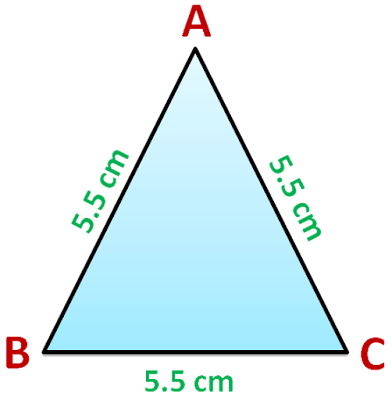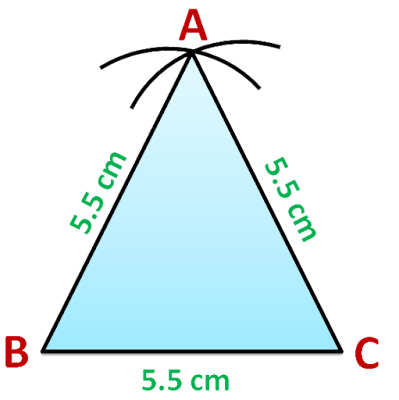Chapter 10 Practical Geometry Exercise 10.2
Question 1: Construct ΔXYZ in which XY = 4.5 cm, YZ = 5 cm and ZX = 6 cm
Answer:
Rough Figure
Actual Figure
Steps of Construction
1. Draw YZ = 5cm.
2. Take Y as a centre, 4.5 cm as a radius draw an arc.
3. Take Z as a centre, 6 cm as a radius draw another arc and it intersects the previous arc at X.
4. Join XY.
5. Join XZ.
6. ⃤ XYZ is our required triangle.
Question 2: Construct an equilateral triangle of side 5.5 cm.
Answer:
Rough Figure
(Property used - In an equilateral triangle all the sides are equal.)
Actual figure
1. Draw BC = 5.5 cm.
2. Take B as a centre, 5.5 cm as a radius draw an arc.
3. Take C as a centre, 5.5 cm as a radius draw another arc and it intersects the previous arc at A.
4. Join BA.
5. Join CA.
6. ⃤ ABC is our required triangle.
Question 3: Draw ΔPQR with PQ = 4 cm, QR = 3.5 cm and PR = 4 cm. What type of triangle is this?
Answer:
Rough Figure
Actual figure
Steps of Construction
1. Draw QR = 3.5 cm.
2. Take Q as a centre, 4 cm as a radius draw an arc.
3. Take R as a centre, 4 cm as a radius draw another arc and it intersects the previous arc at P.
4. Join PQ.
5. Join PR.
6. ⃤ PQR is our required triangle.
Question 4: Construct ΔABC such that AB = 2.5 cm, BC = 6 cm and AC = 6.5 cm. Measure ∠B.
Answer:
Rough figure

Steps of Construction
1. Draw AC = 6.5 cm.
2. Take A as a centre, 2.5 cm as a radius draw an arc.
3. Take C as a centre, 6 cm as a radius draw another arc and it intersects the previous arc at B.
4. Join AB.
5. Join CB.
6. ⃤ ABC is our required triangle.







No comments:
Post a Comment